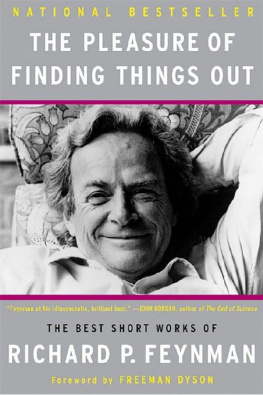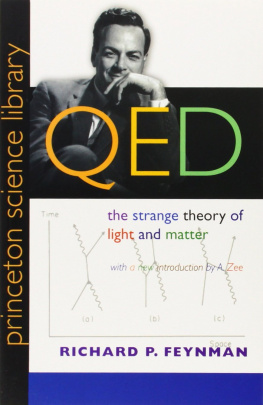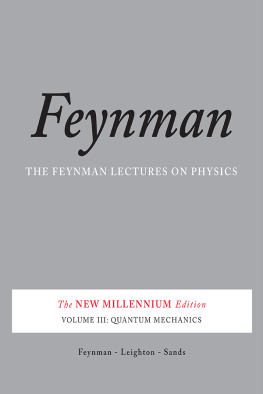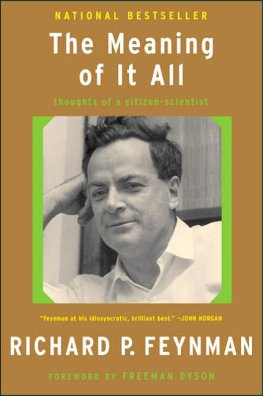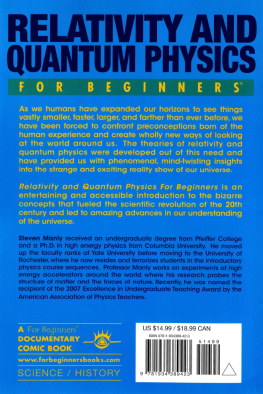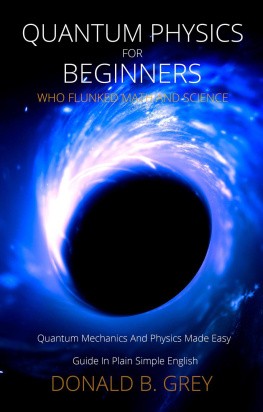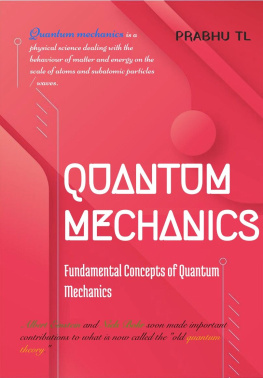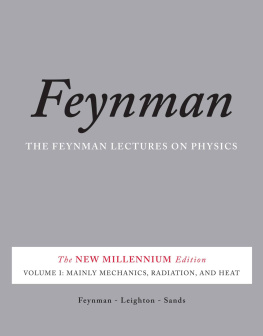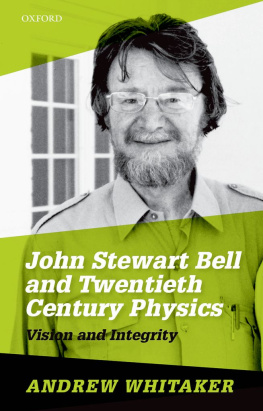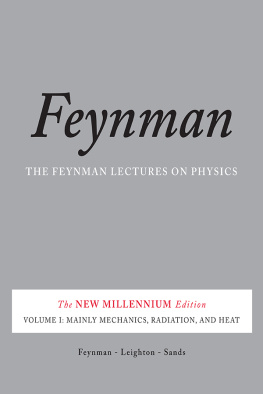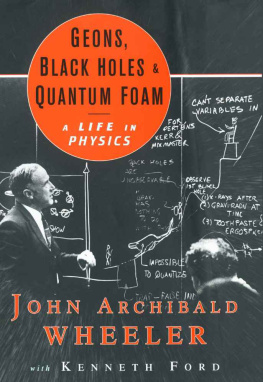ELEMENTARY PARTICLES AND THE LAWS OF PHYSICS

Sketch of P. A. M. Dirac by R. P. Feynman
ELEMENTARY PARTICLES
AND THE LAWS OF
PHYSICS
THE 1986 DIRAC MEMORIAL
LECTURES
RICHARD P. FEYNMAN
California Institute of Technology
and
STEVEN WEINBERG
University of Texas, Austin
Lecture notes compiled by
Richard MacKenzie and Paul Doust

CAMBRIDGE UNIVERSITY PRESS
Cambridge, New York, Melbourne, Madrid, Cape Town, Singapore, So Paulo, Delhi
Cambridge University Press
32 Avenue of the Americas, New York, NY 10013-2473, USA
www.cambridge.org
Information on this title: www.cambridge.org/9780521340007
Cambridge University Press 1987
This publication is in copyright. Subject to statutory exception and to the provisions of relevant collective licensing agreements, no reproduction of any part may take place without the written permission of Cambridge University Press.
First published 1987
Reprinted 1988, 1989, 1991, 1993, 1994, 1995, 1998
First paperback edition 1999
14th printing 2013
Printed in the United States of America
A catalog record for this publication is available from the British Library.
ISBN 978-0-521-34000-7 hardback
ISBN 978-0-521-65862-1 paperback
Cambridge University Press has no responsibility for the persistence or accuracy of URLs for external or third-party Internet Web sites referred to in this publication and does not guarantee that any content on such Web sites is, or will remain, accurate or appropriate. Information regarding prices, travel timetables, and other factual information given in this work are correct at the time of first printing, but Cambridge University Press does not guarantee the accuracy of such information thereafter.
FOREWORD
John C. Taylor
University of Cambridge
Paul Dirac was one of the finest physicists of this century. The development of quantum mechanics began at the turn of the century, but it was Dirac who, in 1925 and 1926, brought the subject to its definitive form, creating a theory as compelling as Newtons mechanics had been.
Dirac immediately set about reconciling the quantum theory with Einsteins special theory of relativity (of 1905). The nature of the marriage between these two marvellous theories, and the fruits of that union, have been the constant preoccupation of fundamental physics from 1925 to the present day. Dirac contributed more than anyone else to this crucial enterprise, including in 1930 the prediction of the existence of antimatter.
Dirac died in 1984, and St Johns College, Cambridge (Diracs college), very generously endowed an annual lecture to be held at Cambridge University in Diracs memory. The first two Dirac Lectures, printed here, are contrasting variations on Diracs theme of the union of quantum theory and relativity.
Richard Feynman, in the years since the Second World War, did more than anyone else to evolve Diracs relativistic quantum theory into a general and powerful method of making physical predictions about the interactions of particles and radiation. His work complements Diracs in a remarkable way. His style of doing physics has been vastly influential. His lecture here, which gives some flavour of that style, expounds the physical reality underlying Diracs prediction of antimatter.
The crowning achievement to date of the relativistic quantum theory has been the unification of electricity and magnetism on the one hand (themselves unified by Maxwell a century ago) with the weak forces of radioactive decay on the other. Steven Weinberg is one of the chief authors of this unification, in work which predicted the existence and properties of new particles (weighing as much as heavy atoms), which were subsequently triumphantly produced, precisely as predicted, at the European laboratory CERN in Geneva in 1983. This echoed Diracs prediction, half a century earlier, of the positron and its subsequent discovery, though the energy necessary to produce a positron was 100 000 times less.
In his lecture, Weinberg shows how tightly quantum theory and relativity together constrain the laws of Nature, and he speculates how Einsteins theory of gravitation (of 1915) will be reconciled with quantum theory.
We in Cambridge were fortunate that these two leading physicists agreed to commemorate Dirac by coming to lecture here. They drew audiences of several hundred undergraduates and graduates, some of them physicists, some not. Both Feynman and Weinberg have been concerned to explain physics to nonspecialists, and we hope that this volume too will interest a wide readership.
Dirac stated his philosophy of physics in the sentence physical laws should have mathematical . Dirac, Feynman and Weinberg have each made beautiful theories which have been spectacularly upheld in experimental tests. But the experiments, outside the scope of these Lectures, are another story.
John Taylor
September 1987
R. P. Feynman, R. B. Leighton and M. Sands (1963). Lectures in Physics, vols. 13. Addison-Wesley.
R. P. Feynman (1985). QED. Princeton University Press.
S. Weinberg (1978). The First Three Minutes. Fontana. (Previously published in 1977 by Deutsch.)
S. Weinberg (1983). The Discovery of Subatomic Particles. Scientific American Library.
See R. H. Dalitz and R. Peierls (1986). In Biographical Memoirs of Fellows of the Royal Society, vol. 32, pp 13786. Royal Society.
THE REASON FOR ANTIPARTICLES
Richard P. Feynman
The title of this lecture is somewhat incomplete because I really want to talk about two subjects: first, why there are antiparticles, and, second, the connection between spin and statistics. When I was a young man, Dirac was my hero. He made a breakthrough, a new method of doing physics. He had the courage to simply guess at the form of an equation, the equation we now call the Dirac equation, and to try to interpret it afterwards. Maxwell in his day got his equations, but only in an enormous mass of gear wheels and so forth.
I feel very honored to be here. I had to accept the invitation, after all he was my hero all the time, and it is kind of wonderful to find myself giving a lecture in his honor.
Dirac with his relativistic equation for the electron was the first to, as he put it, wed quantum mechanics and relativity together. At first he thought that the spin, or the intrinsic angular momentum that the equation demanded, was the key, and that spin was the fundamental consequence of relativistic quantum mechanics. However, the puzzle of negative energies that the equation presented, when it was solved, eventually showed that the crucial idea necessary to wed quantum mechanics and relativity together was the existence of antiparticles. Once you have that idea, you can do it for any spin, as Pauli and Weisskopf proved, and therefore I want to start the other way about, and try to explain why there must be antiparticles if you try to put quantum mechanics with relativity.

Paul Dirac Richard Feynman
Next page

